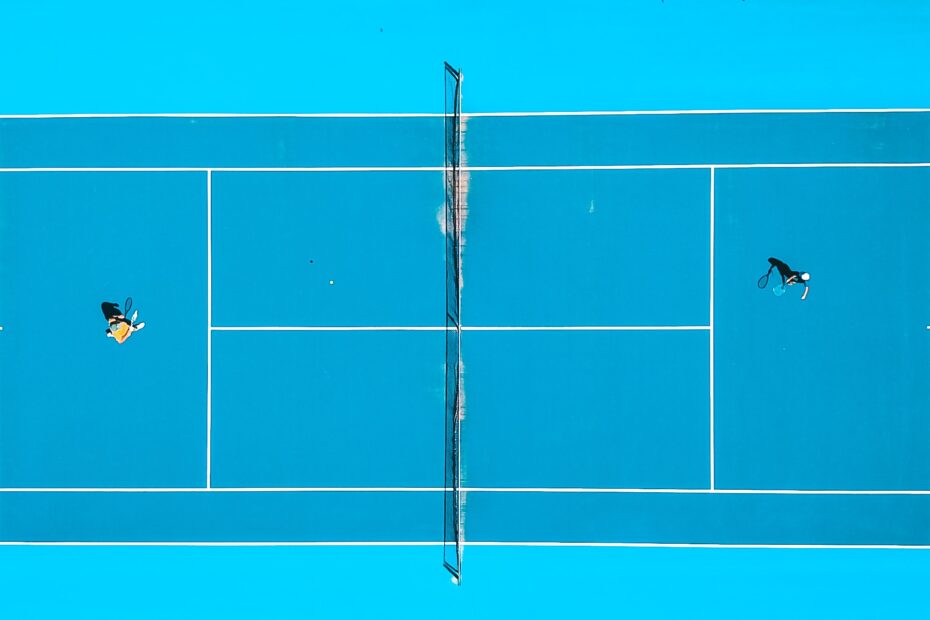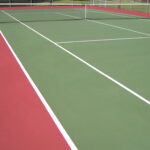From the lush-green grass of the All-England Club, the tedious clay surfaces of the iconic Roland Garros, to the acrylic-topped hard courts of the US Open and Australian Open, Tennis court surfaces hold untold influence in the results of our favourite matches.
Through their differences, and the differences in how the ball interacts with the court surface, the type of surface used on a Tennis court can have a monumental impact on the way the games are played. In fact, some of our favourite Tennis stars, think Carlos Alcaraz, Rafael Nadal, and Novak Djokovic, famously perform better on some courts than others. Nadal’s affinity for the clay courts of the French Open can be no surprise when you consider his awe inspiring 14 French Open Championship titles.
Whether you’re a Tennis lover, a player looking to improve, or just plain old curious, getting to know the various tennis court surfaces, their benefits, and their drawbacks, can be vital.
Grass Courts
Grass courts, a revered and celebrated court surface all cross the Tennis world, bring quite the aura of tradition and prestige to any game, providing any match connotations of the world-class All-England Wimbledon Championships.
The lush green surface of the grass court offers a unique playing experience. One which particularly favours serve-and-volley style players, with a reward experience for any players with exceptionally quick feet. With a reduced bounce, players must have fast reflexes to make each rally their own, take the points, and clinch the win.
Roger Federer is the name we think of when we discuss grass courts. The Swiss Tennis superstar has had absolutely incredible success on the surface across his career. With 8 Wimbledon singles titles, and 12 finals, it really does put into perspective how strong Federer is on grass.
Characteristics of Grass Courts
- Speed and Low Bounce – Grass Tennis courts are famed for their low friction and low-ball bounce, making them the fastest of all professionally used surfaces.
- Slippery When Wet – Grass courts can become incredibly slippery when wet, making footing and movement very difficult. Rain can have such a severe effect on the court that it can be a cause of cancellation, or deployment of preventative measures, think Wimbledon’s famous roof.
- Requires Frequent Maintenance – Grass courts demand meticulous upkeep, including frequent mowing to maintain the grass at an optimal height and uniformity. The surface needs regular watering and rolling to ensure a consistent and even playing field.
- Favouring Serve-and-Volley Players – The quick nature of grass courts rewards players with strong serving skills and the ability to rush the net. Serve-and-volley players thrive on this surface as they can take advantage of the low bounce to finish points quickly at the net.
Clay Courts
The dusky, earthy red and orange hue of the clay court is nothing short of iconic. It’s really no surprise that such a unique court has the hearts of so many Tennis fans and professionals worldwide. If you’re anything like us, Roland Garros, the beautiful venue of the French Open, is the first to come to mind when you think of the clay court surface.
Clay courts offer a slower and higher-bouncing surface, which plays incredibly different to the aforementioned grass court of the iconic Wimbledon. With this, the clay court is a particularly forgiving surface, where defensive minded and strategic Tennis players thrive. But this slower pace leads to longer rallies, which demands immense fitness when competing at the highest level; it really can become a test of endurance.
Rafael Nadal is an absolute monster on the clay court. Simply put, he’s totally dominant on the surface. Celebrating 14 French Open titles (a record between any discipline), and adorning the moniker “King of Clay”, Nadal is just the best on this surface.
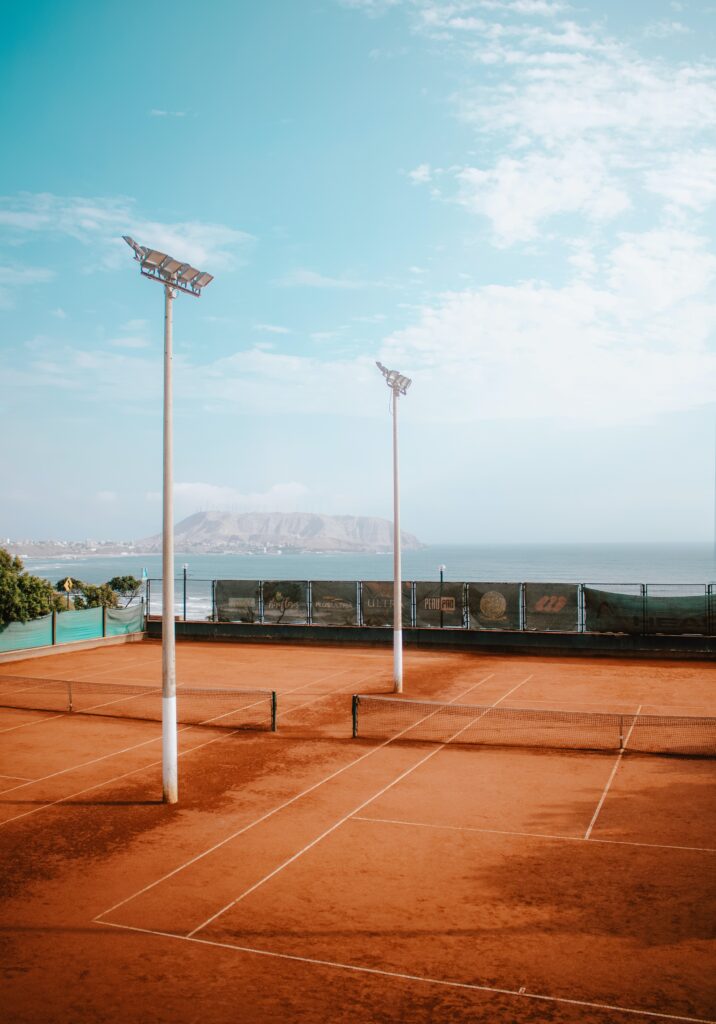
Characteristics of Clay Courts
- Slower Pace and High Bounce – Clay courts are known for their slower playing surface compared to other court types. The clay’s fine particles create higher friction, causing the ball to bounce higher and slower, which rewards players with defensive skills and patience.
- Sliding and Footwork – Players on clay courts often use sliding as a technique to move swiftly and gracefully across the court. Mastering the art of sliding and adjusting footwork is crucial to excel on this surface.
- Rallies and Long Points – The slower pace and higher bounce on clay courts lead to longer rallies and extended points, making matches on this surface more physically demanding.
- Dust and Surface Wear – As matches progress, clay courts tend to develop dust and wear, which can affect ball behaviour and require players to adapt their game as the court changes during a match.
Hard Courts
As the Tennis world celebrates the grass and clay courts of the globe, there is another that stands particularly tall. Hard courts are the chosen surfaces of the US Open and Australian Open and are embraced globally as the most common court. Through its accommodating nature, and versatile surface, hard courts leave an absolutely indelible mark on Tennis, as an exceptional modern innovation of the incredible sport we love.
Hard courts are the epitome of balance, providing an even playing surface which any pro and player can play their own game, unleash their full potential, and stick to their preferred play style. Be it aggressive baseliners wielding thunderous groundstrokes or crafty counterpunchers relying on precise shot placement, the hard court welcomes all players with open arms. The consistent ball bounce and speed allow players to execute their shots with precision, providing a fair, predictable game.
Novak Djokovic is one particular superstar who has made his preference for hard courts known. Known as easily one of the greatest hard-court players of all time, Djokovic has 13 major hard-court titles (10 Australian Open and 3 US Open). Notably, Djokovic also holds the record for 27 Open Era wins of Masters hard court titles. His exceptional footwork, court coverage, and precision make him completely unplayable on this surface.
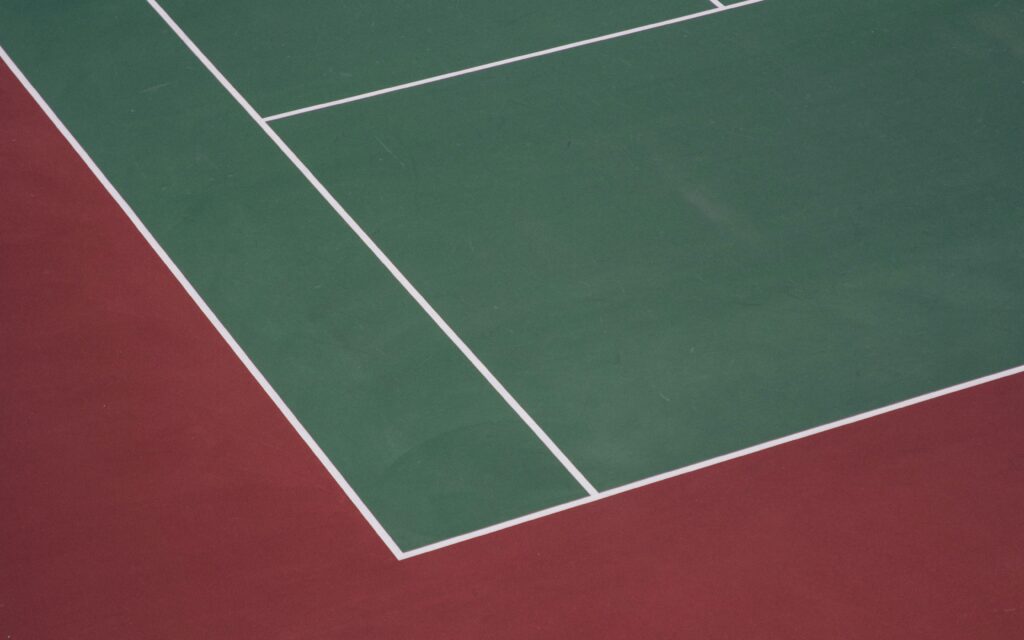
Characteristics of Hard Courts
- Medium/ Fast Playing Speed and Consistent Bounce – Hard courts provide a predictable and consistent bounce of the tennis ball, allowing players to develop precise timing and shot execution.
- Favourable for Aggressive Players – The faster pace of hard courts favours aggressive players who like to hit powerful shots and take control of points.
- Durable and Low Maintenance – Hard courts are durable and require relatively low maintenance compared to other surfaces like grass or clay. They can withstand the wear and tear of frequent play, making them ideal for year-round tennis.
- High-Speed Servers Advantage – Hard courts favours players with strong serving skills, as the surface allows for faster ball speed and less ball rotation.
Carpet Courts
A surface of yesteryears, Carpet courts have fallen out favour in the Tennis world. Now just a blast of nostalgia, Carpet courts were once a prominent feature of the professional circuit. Through their difficult maintenance and the rise of other surface types, Carpet courts now just offer a whisper of Tennis history gone by.
Carpet courts, as the name suggests, boast a surface that mimics the feel of a carpet underfoot. This smooth glide grants players an effortless elegance and fluidity in their movements, making the court an artistic canvas for showcasing their skills. The playing speed falls somewhere in the middle, encouraging a blend of tactical play and aggressive shot making. Tournaments held in arenas and indoor facilities often favoured carpet surfaces, creating a controlled environment for competitive matches. While carpet courts may have faded from the limelight, they remain a cherished part of tennis history, evoking nostalgia, and fond memories for those who witnessed the magic of the surface in its prime.
Great champions of the past, like Ivan Lendl, Bjorn Borg, and John McEnroe, have left their mark on carpet courts, showcasing the grace and artistry that defined this unique surface. Though modern tennis has moved on to embrace other court types, the legacy of carpet courts lives on in the hearts of those who remember their bygone allure, reminding us of the sport’s ever-evolving journey through time.
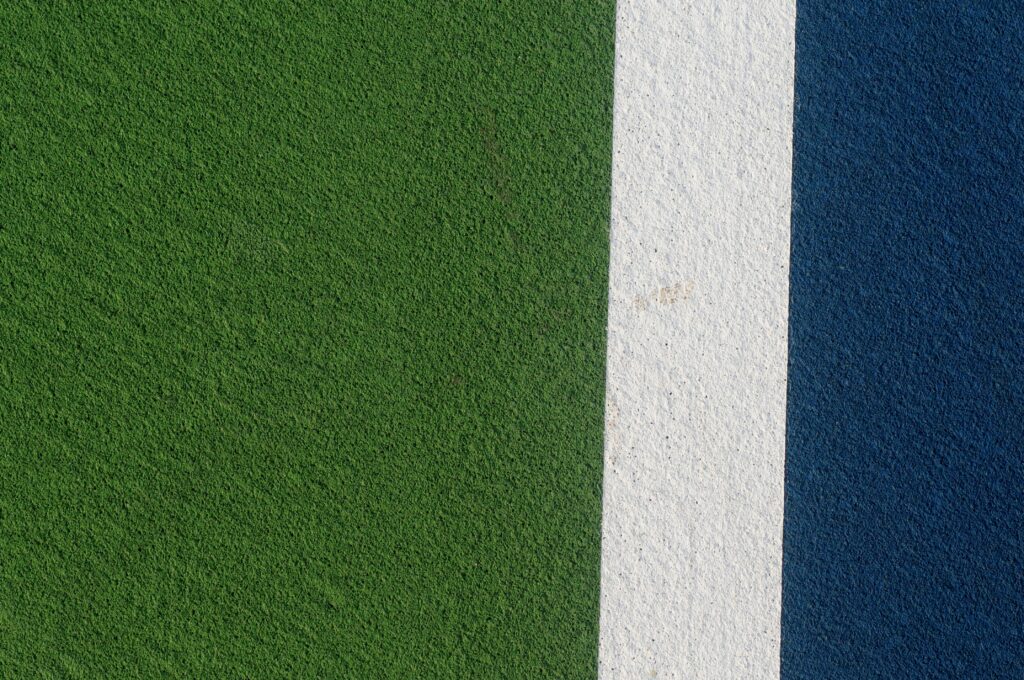
Characteristics of Carpet Courts
- Smooth Surface – Carpet courts have a smooth and even surface that allows players to glide effortlessly across the court. This characteristic is reminiscent of playing on a carpet, hence the name “carpet courts.”
- Medium-Fast Playing Speed – Carpet courts offer a medium-fast playing speed, providing a balance between the slower clay courts and the faster hard courts. This speed encourages a dynamic and aggressive style of play.
- Consistency and Predictability – The playing characteristics of carpet courts are consistent and predictable, enabling players to develop precise timing and shot execution.
What Surfaces Do Grand Slams Use?
Australian Open
The Australian Open is perhaps most famous as the first Grand Slam event of the tennis season. Melbourne based, and founded in 1905, the Australian Open was originally known as the Australasian Championships. Initially the Australian Open was held on Grass courts, but made the switch to hard in 1987 to a hard court known as “Rebound Ace”, and has switched hard court type multiple times since, now using a blue “GreenSet”. The event is held at the Melbourne Sports Complex, with the Rod Laver Arena serving as the main ground.
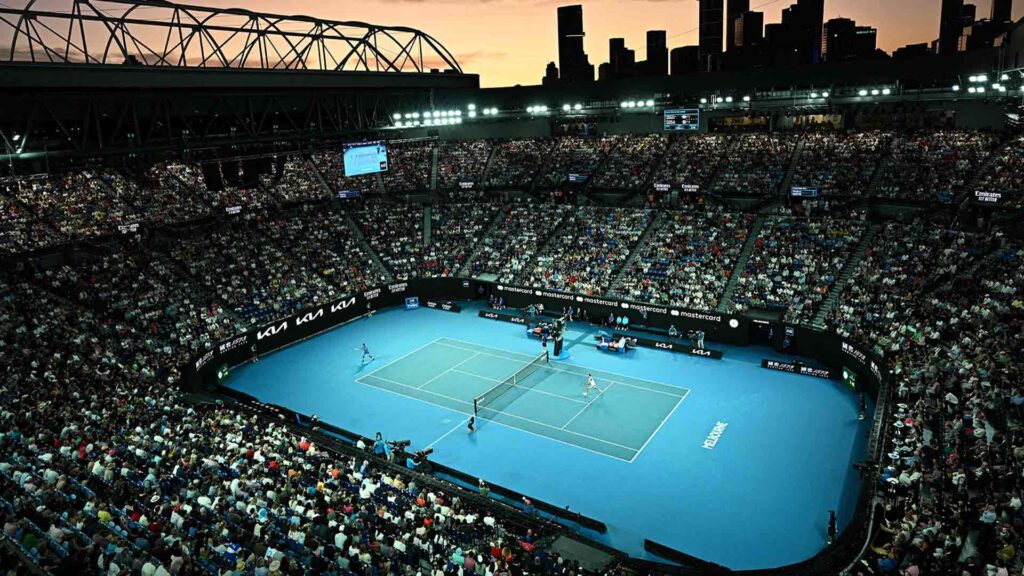
Australian Open’s Rod Laver Arena
French Open
The French Open, affectionately known as Roland Garros after a French Military hero, is the second grand slam event in the tennis season. Held annually in Paris, France, the French Open was founded in 1891, and is most famous for its use of orange clay. Originally the French Open was a grass court event, but transitioned to its iconic clay in 1928, defining the character of the tournament.
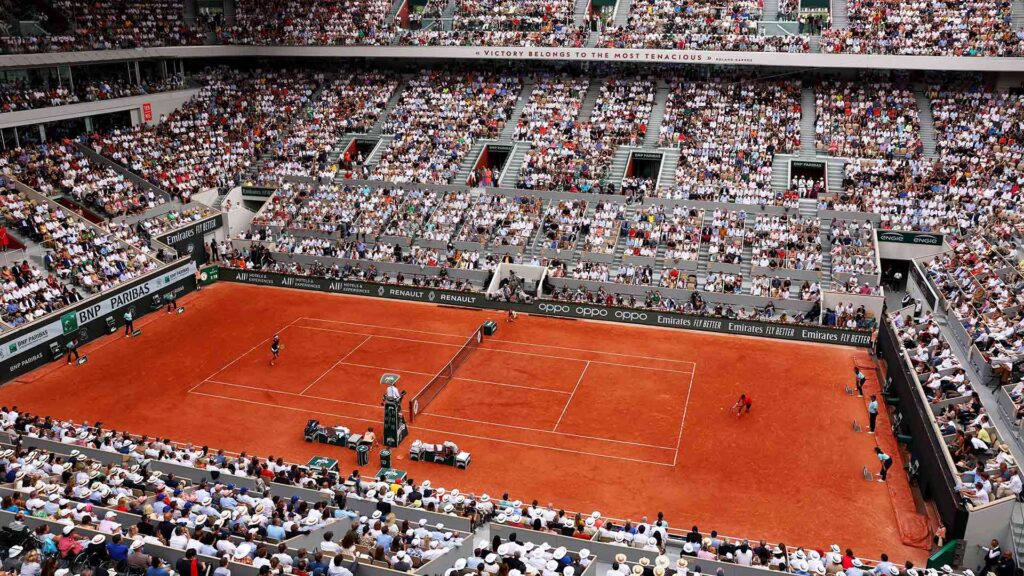
The Roland Garros Arena and its clay court.
Wimbledon
Wimbledon is arguably the most prestigious Grand Slam of them all. Founded in 1877, it is the third grand slam of the tennis season, hosted in London, England at the All-England Lawn Tennis and Croquet Club. Wimbledon is renowned for its continued use of grass courts, as although each Grand Slam has at one point utilised the surface, The Championships are the only one to still do so.
US Open
The final Grand Slam of the tennis season, the US Open is held annually in New York City, USA. Established in 1881, the US Open is held at the USTA Billie Jean King National Tennis Centre in Flushing Meadows. The tournament originally used grass surfaces, but transitioned to clay in 1975, and later to the current hard courts in 1978.

US Open at The USTA Billie Jean King National Tennis Center
Bonus: ATP Masters Tournaments
- Indian Wells: Hard
- Miami Open: Hard
- Monte-Carlo Masters: Clay
- Madrid Open: Clay
- Italian Open: Clay
- Canadian Open: Hard
- Cincinnati Open: Hard
- Shanghai Masters: Hard
- Paris Masters: Hard
Where can I find Tennis Courts? Book a Game with Aceify
As we’ve explored the diverse world of Tennis court types, you may be wondering which surface you’re best suited to. With Aceify, we’re sure you’ll soon find out! We’re a London based hub for finding tennis tutors and courts, and you can use our service to try the surfaces mentioned here in this article. It’s time to ace your game, one match at a time, with Aceify by your side. Sign Up Today!
Conclusion
In conclusion, the diverse world of tennis court surfaces holds immense influence over our favourite matches, from the prestigious grass courts to the enduring clay and the versatile hard courts. Each surface offers a unique playing experience that caters to different playing styles and showcases the brilliance of legendary players like Roger Federer on grass, Rafael Nadal on clay, Novak Djokovic on hard courts, and the nostalgic charm of carpet courts graced by champions like Ivan Lendl, Bjorn Borg, and John McEnroe

